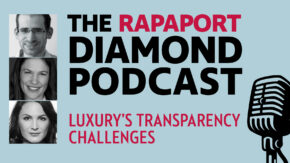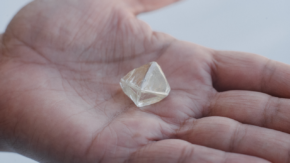Two diamond professionals talk about their journeys through the industry, and what they’ve learned along the way.
The cutter: Michaël Suchowolski, Owner Mac Precious Stones/ Mac Cutting Works
How did you get started in the diamond industry?
I have been working at the Diamond Club in Antwerp for 36 years, taking over my father’s and grandfather’s cutting business, which was established before World War II. My three sons are also working in the business, with my 19-yearold son training as a cutter.
We specialize in recutting, as well as being the only diamond cutter in Antwerp to also polish rubies, sapphires and emeralds.
How has the job of a cutter changed?
Between my grandfather’s cutting work and our job, it’s like night and day. The wheel, platforms and discs on which we work have changed a lot in the past decades. The technology to measure the stones has evolved so much. We work with Sarine and Helium machinery, which is also used by the Gemological Institute of America (GIA).
You still need an excellent eye, a lot of patience, and to be very meticulous to create an impeccable diamond.
What do you like the most about your job?
Our job is to make the stone even more beautiful. The majority of the most beautiful stones (triple Ex) are cut in Antwerp for high-jewelry houses. For instance, fancy baguette and princess-cut diamonds go to the Swiss watch market or jewelers on the Place Vendôme.
What’s the future like for cutters?
I have seven people working at Mac Cutting Works, including a young woman. My three sons have studied gemology and have enrolled in HRD [Antwerp]’s cutting course, which teaches the basic skills. There are always opportunities for new cutters to join the trade, as it’s very rare to find good cutters. We need more young cutters.
Antwerp’s cutting industry is nowhere near the scale of cutting factories like the ones you see in India, where 2,000 to 3,000 people can work in one unit, but it’s still a center renowned for its highly skilled cutters.
What’s the most essential skill for a cutter?
A cutter needs to be very flexible. This is not a 9-to-5 type of job where you can close the shop on the dot and head back home. Clients are pressed for time all the time. You cannot tell them it will take three to four weeks these days. Clients have every right to be demanding, as it’s such a costly product. They want the delivery to be as quick as possible.
At the same time, it is complex work to cut the stone. You have to see where the stone grows; you cannot rush it. It takes one to two days to assess the stone, then one to two weeks to work on the wheel. Each stone is checked at least three times in a binocular microscope to make sure the diamond is perfect.
The manufacturer: Marc Knobloch, Vice president Aron Knobloch Inc.
How did you train to become a diamond manufacturer?
My training as a diamond wholesaler really began, informally, when I was very young and before I was ever regularly active in the trade. In my younger years, several trips to the office during school vacations planted the seed of curiosity and wonder about the sparkly rocks that were so important, my father would make regular trips to Russia to source and buy them.
The eagerness to learn more led me to work in the trade more while in high school and college. While not being very complicated work, running errands, cleaning diamonds, learning about cutting, etc. offered me the chance for additional exposure to many, many facets (please pardon the pun) of the diamond trade.
Eventually, the understanding gained during those early years led me to join my family’s firm, Aron Knobloch Inc., as the third generation. Engaging in daily diamond wholesaling activities, and formal GIA training paired with practical experience, quickly enhanced my understanding of diamonds and sharpened my skills.
What specific skills do you need to have?
Before any formal or informal training, you certainly need to have burning, insatiable passion. Passion for diamonds themselves, designing jewelry incorporating diamonds, the history of diamonds, etc. certainly is a step in the right direction.
Beyond that, the level of learning provided by the GIA is wonderful. And if one is lucky enough to reinforce those classroom/textbook lessons learned at the GIA with active participation in the industry, I think that is the most ideal situation one could ask for.
What’s the most challenging aspect of your job?
The greatest challenge of my job is to convince my retailer customers not to be blinded by all the gemological certificate information that exists. I encourage them to put that information aside, if only temporarily, and admire a diamond simply for the beauty that they see or may not see. Diamonds rely on visual beauty, so why not just judge them on that basis?
Sure, the numerous measurements, attributes, etc. of a diamond are important, but such a strong focus on them causes one to almost completely lose sight of the bigger picture…. If an award-winning chef uses the optimal measurements of the right combination of ingredients, but the resulting dish does not taste good, then everything else really no longer matters, does it?
How do you see your job evolving over the years?
My job’s future evolvement will be even more multifaceted (again, please pardon the diamond pun) as I further develop my skills in aesthetics and design. The diamond is usually the focal point of the jewelry it is in, but not always. Jewelry manufacturing techniques, as well as materials, continue to evolve, and each of these poses new and unique design feasibility and marketing challenges.
It is also my hope that the sense of bliss felt when appreciating beauty for beauty’s sake will extend to many more diamonds beyond those larger, more notorious pieces featured from time to time in the media.
Image: iStock photos




